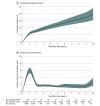Long-Term Risk of Stroke After Transient Ischemic Attack or Minor Stroke: A Systematic Review and Meta-Analysis
- PMID: 40136306
- PMCID: PMC11947970
- DOI: 10.1001/jama.2025.2033
Long-Term Risk of Stroke After Transient Ischemic Attack or Minor Stroke: A Systematic Review and Meta-Analysis
Abstract
Importance: After a transient ischemic attack (TIA) or minor stroke, the long-term risk of stroke is not well-known.
Objective: To determine the annual incidence rates and cumulative incidences of stroke up to 10 years after TIA or minor stroke.
Data sources: MEDLINE, Embase, and Web of Science were searched from inception through June 26, 2024.
Study selection: Prospective or retrospective cohort studies reporting stroke risk during a minimum follow-up of 1 year in patients with TIA or minor stroke.
Data extraction and synthesis: Two reviewers independently performed data extraction and assessed study quality. Unpublished aggregate-level data on number of events and person-years during discrete follow-up intervals were obtained directly from the authors of the included studies to calculate incidence rates in individual studies. Data across studies were pooled using random-effects meta-analysis.
Main outcomes and measures: The primary outcome was any stroke. Study-level characteristics were investigated as potential sources of variability in stroke rates across studies.
Results: The analysis involved 171 068 patients (median age, 69 years [IQR, 65-71]; median proportion of male patients, 57% [IQR, 52%-60%]) from 38 included studies. The pooled rate of stroke per 100 person-years was 5.94 events (95% CI, 5.18-6.76; 38 studies; I2 = 97%) in the first year, 1.80 events (95% CI, 1.58-2.04; 25 studies; I2 = 90%) annually in the second through fifth years, and 1.72 events (95% CI, 1.31-2.18; 12 studies; I2 = 84%) annually in the sixth through tenth years. The 5- and 10-year cumulative incidence of stroke was 12.5% (95% CI, 11.0%-14.1%) and 19.8% (95% CI, 16.7%-23.1%), respectively. Stroke rates were higher in studies conducted in North America (rate ratio [RR], 1.43 [95% CI, 1.36-1.50]) and Asia (RR, 1.62 [95% CI, 1.52-1.73]), compared with Europe, in cohorts recruited in or after 2007 (RR, 1.42 [95% CI, 1.23-1.64]), and in studies that used active vs passive outcome ascertainment methods (RR, 1.11 [95% CI, 1.07-1.17]). Studies focusing solely on patients with TIA (RR, 0.68 [95% CI, 0.65-0.71) or first-ever index events (RR, 0.45 [95% CI, 0.42-0.49]) had lower stroke rates than studies with an unselected patient population.
Conclusions and relevance: Patients who have had a TIA or minor stroke are at a persistently high risk of subsequent stroke. Findings from this study underscore the need for improving long-term stroke prevention measures in this patient group.
Conflict of interest statement
Figures


References
-
- Kleindorfer DO, Towfighi A, Chaturvedi S, et al. 2021 Guideline for the prevention of stroke in patients with stroke and transient ischemic attack; a guideline from the American Heart Association/American Stroke Association. Stroke. 2021;52(7):e364-e467. doi: 10.1161/STR.0000000000000375 - DOI - PubMed
Publication types
MeSH terms
Grants and funding
LinkOut - more resources
Full Text Sources
Medical

